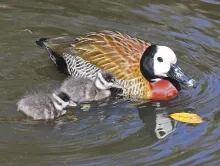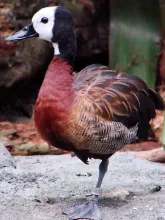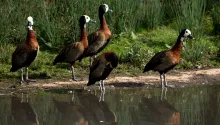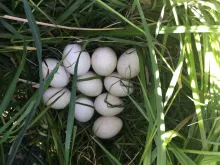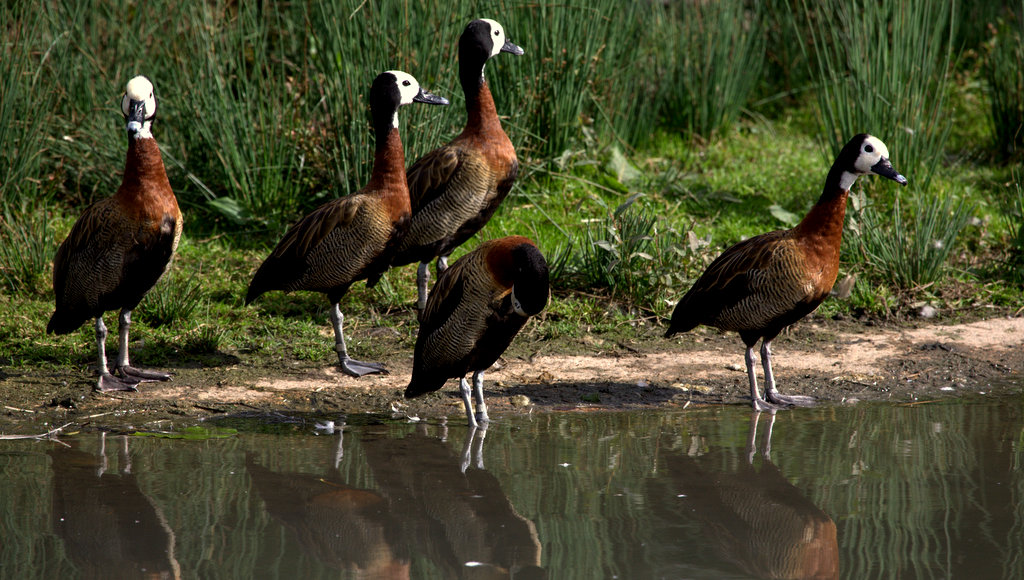
White-faced Whistling duck (Dendrocygna viduata)
Species name
- Dutch name:
- Witwang fluiteend
- English name:
- White-faced Whistling duck
- German name:
- Witwenpfeifgans
- French name:
- Dendrocygne veuf
- Scientific name:
- Dendrocygna viduata
Scientific classification
- Order:
- Anseriformes
- Family:
- Anatidae
- Onderfamilie:
- Dendrocygninae
- Genus:
- Dendrocygna
Description
- Description:
Male:
has white face, throat and forehead, from half crown, crossing behind the eyes to the throat, forming a beautiful contrast with black head back and upper nape. A chestnut wash goes down to the front, until the bottom and the hind neck, and on upper chest. Lower chest, belly and tail are black. Flanks are finely barred with black and white waves. Upperparts are dark brown, with wings bordered with buff, and particularly scapulars. Wings are dark brown. Bill is black with pale band at tip. Eyes are dark brown. Legs are grey.Female:
As male but smaller and a little duller.Juvenile:
Duller over all. Face and throat are grey or pale buff, chest is relatively dull chestnut. Chicks have dark olive-brown upperparts with large yellow patches on wings and back. Underparts are yellow. Face is streaked. Bill and legs are grey.
- Behaviour:
Sometimes mix with Fulvous whistling-ducks (Dendrocygna bicolor) and Black bellied Whistling duck (Dendrocygna autumnalis) in loafing areas, but within these aggregations they generally remain in groups of their own species. Form strong, probably life-long pair bonds.
Standard Measurements
- Body Length (cm):
- The male (drake) of the White-faced Whistling duck measures approximately 38-48 centimeters. The female measures approximately 38-48 centimeters.
- Body Weight (grams):
- The male will weight about 455-680 gram. The female will weight about 455-680 gram.
The weight is notoriously variable and can only be used as indication!
- Note:
Whistling-ducks generally do well, either in pens or in a park with access to extensive water area and good natural cover. They are gregarious outside the breeding season, and groups may bully smaller duck species, so should be kept in large areas, in which other birds have room to escape. Most need shelter in severe weather and a well-sheltered pen with frost-free night quarters for winter is suggested, or plenty of ground cover and/or straw to stand on, as they are susceptible to frostbite. They may be kept fully-flighted in aviaries, and have also been kept full-winged in open pens, tending not to wander. Perches should be provided at an appropriate height for pinioned or wing-clipped birds. Commercial pellets and grain are suitable for feeding.
Elevated nest boxes are appreciated by most species, although pinioned birds will use ground-level boxes; boxes may be placed over water or land. Eggs may be incubated by bantams and ducklings may be bantam-reared. Many species have been successfully parent-reared in captivity. Pairs kept isolated and fully flighted in a covered pen, with high-hung nest boxes "seldom fail to rear broods". Whistling-duck species may hybridise with one another and therefore should be kept in separate enclosures, and hybridisation has also occasionally been reported with Rosy-billed pochard (Netta peposaca).
White-faced whistling-ducks are relatively hardy as adults, easy to keep and attractive in mixed collections. Plentiful water, area for seclusion and opportunities for perching should be provided. They require indoor accommodation in severe/frosty weather. These ducks may be fed grain, pellets, green food, bread.
White-faced whistling-ducks are fairly easy to breed. They sometimes nest in ground vegetation, may also use a ground-level or raised nest box or a hollow log screened with vegetation, usually laying in late April to June. Ducklings may be parent hatched and reared, or an incubator or broody may be used. Care and protection are important for the ducklings initially.
- Breeding:
- The female White-faced Whistling duck usually lays from 6-12 creamy white and not shiny eggs and incubates them for 26-30 days.
- Artificial incubating:
The ideal relative humidity for incubating most waterfowl eggs is 55% (ground nesters) and 40% (cavity nesters). The temperature is usually 37.4°C. Set ventilation as recommended by the incubator manufacturer. Eggs must be turned, either automatically or by hand, a minimum of 4 times a day. As the duckling develops there is a loss of water from the egg and the air sac gets bigger. In normal development of an egg with a 26-30 days incubation, the air sac occupies about a third of it three days earlier. Cleanliness is vital and ideally eggs should be moved to a separate hatcher at this point, where the humidity should be increased to 65% and even higher once they have pipped internally.
- Bird banding:
- Recommended closed leg band ring size for the White-faced Whistling duck is 11 mm.The leg band ring can only be applied on a young whistling duck at around 12 days old.
- It doesn't matter what leg that you band, but it's good to have a consistent system. Suggested: Left leg = Female, Right leg = Male
- Maintenance food:
-


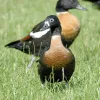


Floating full food for all sea ducks, green ducks, eider ducks and geese, especially in the moulting and breeding phase ideally suited. Packed with wholesome raw materials, natural vitamins and trace elements, this performance food with a protein content of 30% forms the basis for lifelong vitality.


